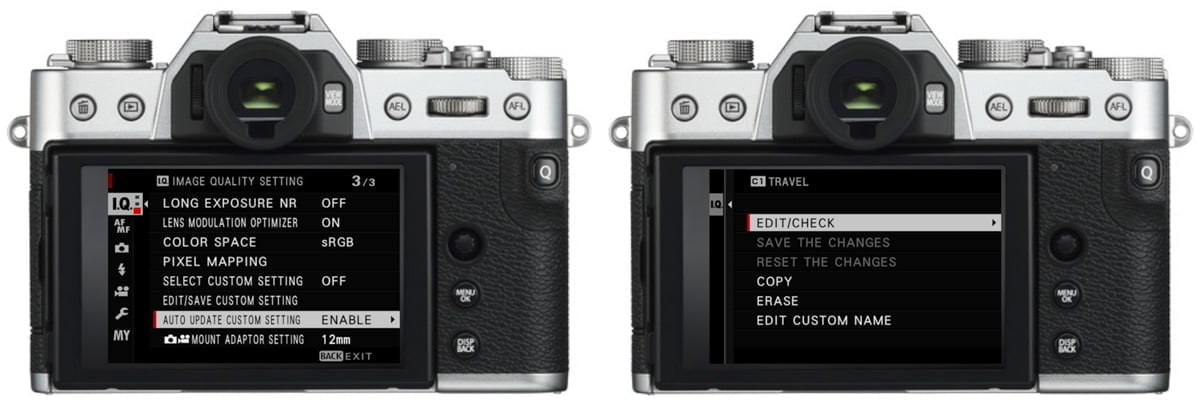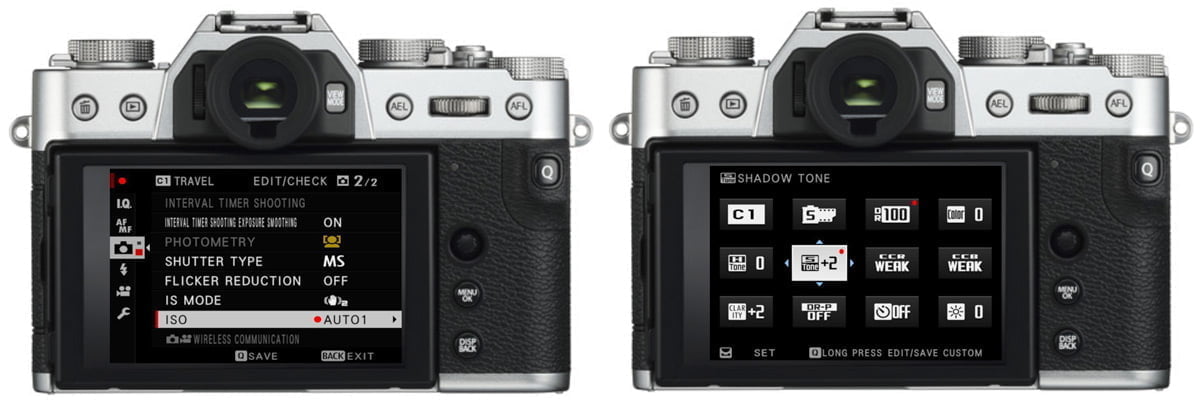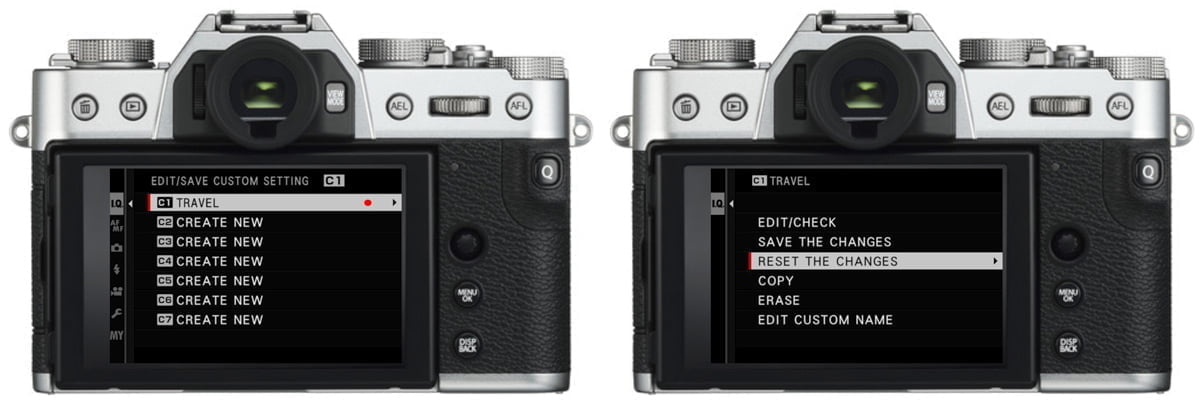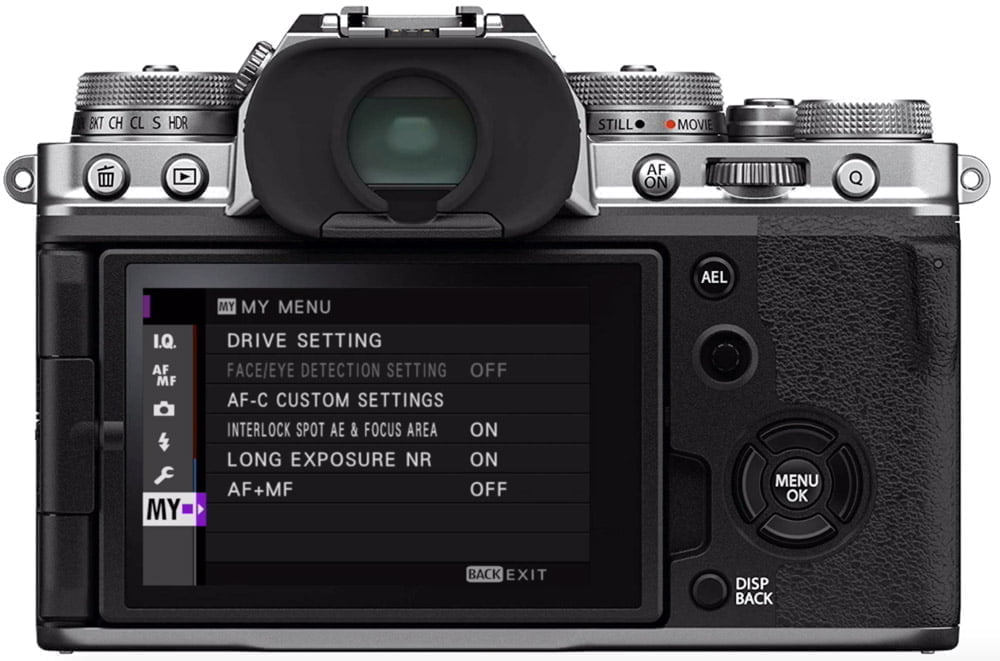Disclosure: This post may contain affiliate links. I earn a small commission of product sales to keep this website going.
I was absolutely infuriated with Fujifilm’s new Custom Setting structure when I first used the X-E4. I should have known this was coming since the X-S10 had similar changes. And there was a glaring bug in the firmware that kept it from working properly, so there’s also that (it’s since been fixed).
But this is where things are headed, and now that I’m using the X-T30 II as a secondary body, it’s time to accept it.
This is how I’m transitioning to Fujifilm’s new Custom Settings system in the X-T30 II after years of using the completely different old system.
I do have a walkthrough of setting up all of these options, along with the rest of the X-T30 II settings, in my Fujifilm X-T30 II Tutorial course.
Who is this article for?
When I published my first aggressive article & video about the new X-E4 Custom Settings, comments flooded in with “it’s about time they’re doing this!” “Other camera brands do it this way, Fujifilm finally got on board!” “What’s wrong with you for not liking this?” You people are just fine then, no need to keep reading. This is what you’re used to and transitioned right into it without any problem.
But an even greater number of comments were along the lines of, “this is an absolute disaster for the way I shoot and how I’ve been using Custom Settings for ten years!”
Custom Settings in Fujifilm cameras have always been a way of styling our photos. Not quickly recalling focus settings and whatnot. It was different from other camera brands for a reason. All those other camera function settings are irrelevant and independent of our styling. This new system isn’t an “upgrade” or “addition,” it’s completely different functionality for a completely different purpose.
This article is for the latter group trying to wrap their heads around how to still make use of Fujifilm’s new Custom Settings.
Real-world frustration scenario
So I took the X-T30 II to Peru with me as a secondary body; I had to retire my X-E3. The lack of the rear command dial and focus mode switch on the X-E4 was an absolute no-go for the way I shoot. The X-T30 II was the next choice for a secondary body to match my X-T4 innards.
I knew I’d have some problems in the beginning with the new Custom Setting setup in an assignment environment. But at least I was prepared to look out for this.
So here are just a few examples of some problems I had the first couple of days. I did eventually minimize these things being a problem and I explain that later.
MF ASSIST
I had a wide MF-only lens on my X-T30 II while shooting indoors in a tight environment. It was easiest for me to use Red Focus Peak Highlight to quickly focus so I set that after turning on the camera. I’d turn the camera off and go back to my X-T4 for closeups. Then pick up the X-T30 II again for another wide shot and it’d be reset to Standard MF Assist. I’d long-press the Rear Command Dial to get back to Focus Peak, but the color was White, which is useless. So I’d have to go back into the AF/MF menu and set it back to Red. This was a few minutes of WTF-style panic. Where’s my red? Ah, that’s part of the programming now.
FOCUS MODES
I was then at the beach shooting some surfing lessons and had my telephoto lens on my X-T30 II. The X-T30 II AF-C Tracking works pretty well; I set this while tracking students catching some waves. I’d go back to my X-T4 for some beach photos. Then see a student about to get up on the board, flip on my X-T30 II to start tracking them, but the Focus Area would be reset to Single Point, not Tracking, and I’d miss the focus – and the ride.

These are just two things that happened to me in the first two days and is a great example of why I tell people to never bring a new camera on an important trip 🙂
Using the Auto Update Custom Setting
Fujifilm’s new Custom Settings has an Auto Update Custom Setting feature. I was hesitant to use this for one reason.
I worked hard to come up with my “film recipes” and didn’t want to chance losing those as I made small contrast & color adjustments for current lighting, color schemes, etc.
If Auto Update Custom Setting is Enabled, any changes you make will be preserved when you turn the camera off and back on, or go to a different Custom Setting and come back.
Sounds great, but won’t that overwrite your original custom setting? What happens when you want to go back to the image styling as it was originally programmed?
Well, you can’t. There’s no quick way to go back to the original settings if Auto Update Custom Setting is enabled.

I’m a nerd and have always had a spreadsheet in the cloud with my Custom Setting programming. I’m just going to have to go to that sheet if I do make any changes.
But maintaining any changes to the focus & shooting settings is far more important to me when I’m on a shoot and cycle the camera power. Those “surprises” of being in a different autofocus mode than what I was expecting are just too costly.
Enabling this feature really helped minimize the frustrations in those scenarios I mentioned earlier, even if it does cause me to lose my original settings.
If you don’t have this feature enabled, any changes you make will have red dots next to them. You can go into the Edit/Save Custom Setting menu and choose to save those changes or reset back to the original settings. Those changes will be automatically reset when you cycle the camera power if you do neither of those things.


How to set up the Shooting & AF/MF Menus
If your image styling isn’t tied to a specific focus mode, shutter type, and so on, then how do you program those things since you must program those things?
I looked at my various image styles – the seven custom settings I have across all of my X-series cameras – and asked myself when I most likely use them.
My “Portrait” style that uses Pro Neg Hi, as you might guess, was designed for outdoor environmental portraits. So I set my focus & shooting settings as I would usually want them for outdoor environmental portraits.
I don’t always use it for outdoor environmental portraits though; it was my default styling for my entire Peru trip and I was photographing a range of subjects that require different focus & shooting settings. This is where Auto Update Custom Setting helped me use the camera as I had always been used to with Fujifilm.
My “Landscape” style that uses Velvia, go figure, was designed for landscapes. I programmed my focus & shooting settings as I have them for most landscapes.
But again, on this trip, there are some marvelous dusk opportunities in this town where this image style works great but the rest of the camera settings do not.
Help with My Menu
My Menu can be a big help here. Be sure that you’ve set up My Menu so that you can quickly access these focus & shooting settings from one menu page rather than hunting around for them.
You can read how to set up My Menu here.

Nothing Selected
If all of this is just too much, you always have the option of choosing “Nothing” for the Custom Setting. Any changes you make in any of the menus will just always be there until you directly change them again. No surprises when you cycle camera power.
My wish
If anyone from Fujifilm is reading, my wish would be for us to choose whether or not certain settings are included in a Custom Setting. Like if I don’t want a Shutter Type programmed to a custom setting at all, let me choose not to include it.
I know this will take a good amount of coding to get done but it’s not impossible. That’s my wish 🙂
How else are all of you old curmudgeons dealing with it?

Hans
Sunday 18th of August 2024
By the way, my Fujifilm X-T30ii isn't showing the focus square on my lcd screen by default. Like on my other Fuji cameras. I have to press the joystick first than it shows the (green) focus square. With my other Fuji cameras the white focus square immediately shows when turning my camera/lcd screen on. Not with my X-T30ii.
John Peltier
Sunday 18th of August 2024
Check that "Focus Frame" is enabled in the Disp. Custom Setting submenu, in the Screen Setting menu.
Hans
Sunday 18th of August 2024
Hello John, I am from Holland and wanna thank you for your article. I own a X-T1, X-T4 and the X100V. Using the 7 custom slots for my own film simulations. Whatever film simulation I pick, the camera holds my last used ISO setting. When I set ISO to 400 when using one of the built-in simulations, it's holding ISO 400 when switching to another film simulation. Even when I use one of the 7 simulations from the custom slots. This week I bought the X-T30ii. And it was driving me crazy. When using one of the 7 custom slots, the camera is holding each ISO setting I was using the last time. When using custom setting 2 with ISO 400 and later on using custom setting 5 with ISO 250, these ISO settings keep unchanged. Suppose I like the film simulation of custom setting 5, using ISO 250 and than change to custom setting 2, it doesn't hold ISO 250 but used the last ISO setting of custom setting 2, which was ISO 400. So now when changing from one custom setting to another I also have to change my ISO setting. The crazy thing is, it only happens when using the custom settings. When changing between the built-in film simulations, my ISO setting keeps the same... Very annoying... Cheers, Hans
John Peltier
Sunday 18th of August 2024
Hi Hans, thanks for writing! I am just as annoyed :) In fact, it was one of the reasons I switched to Nikon last year for my professional work, because switching Custom Settings during a shoot was causing me to miss shots. I had become so accustomed to the "old" way of the Custom Settings. It's unfortunate that all settings - including shooting and focus settings - must be saved to individual custom settings. It's further compounded with the "Auto Update Custom Setting" function found in the Image Quality Setting menu, which can cause problems whether that's enabled or disabled. I finally did find a way to work around it: Stop using Custom Settings altogether, and switch to a different manufacturer. Not the solutions I had hoped for.
Dusenberg
Saturday 4th of November 2023
Hi, great thread!
I am seriously considering a GFX100S to replace my Nikon D850 and I hadn't known it had the same issues I experienced with a Nikon Z7 until I read this. Now I think I'll park it or maybe see if I can rent one to try out before I buy. So thanks!
I encountered the same problems with a Nikon Z7, having 'upgraded' from a Nikon D810 (which I fortunately kept). The D810 had a seperate set of (4 each) 'memory banks' for customised 'shooting' and 'custom settings' ( ie 16 combinations). These were NOT tied to a 'pasm' dial but were changed via menu. So I could have my 'landscape' shooting settings and use any of the 4 custom settings etc etc. Any changes would be automatically saved to the current setting at power-off. Very flexible and easy. My Menu told me what changes I'd made PLUS each set of custom settings could be backed up to the memory cards so if I screwed up something I could simply reload the original custom settings (ie just the 'landscape' settings, or all of them). Really good. The Z7 was hopeless - the same as you and others have articulated so well here - and after 4 months of trying to use it for my landscape and general on-the-move work I gave up with it - too many user-erors, far too much UNCERTAINTY and STRESS. A costly mistake! I went back to the D810 which I later upgraded to D850 ( same customisation capability as the D810 ) - and back to happy photography. Who would have thought something that sounds so inocuous as 'custom setting' can render a camera unusable!
Interestingly only the 'D8*' and newer mirrorless Z8/9 Nikons aimed at pro-users have this multi-memory bank capability, the consumer grade D and Z models have the dreaded pasm dial. So I was very surpised the GFX suffers from same constraint.
Marc Jaffe
Sunday 29th of October 2023
Hi. I read your article with reckless abandon. I have had my X-T30ll for a few days I have 3 distinct styles that I set custom programs for. My issue is one of my styles requires a focus lock at 15’. I accomplished this with setting to force the focus A/B to 15’. It works. But then I need to switch it back to off for a different setting. I was hoping the settings for the actual buttons were part of the customization as well as other key focus and exposure settings. I mostly have things off and use manual focus. I also have the peak set to red and that’s great for my DayShots but not my NightShots. The system can’t see. I plan on doing as you suggested turning off saving customizations and more my menu. I have dialed in my DayShot needs but still tweaking 2 different NightShots. Thanks for some more direction.
John Peltier
Friday 3rd of November 2023
I suppose you could just have one dedicated setting to the A/B 15' position - but then you have to decide what you're going to save for all of the other settings for that program. I can't think of any other way around it!
Martino
Wednesday 19th of July 2023
Hi! Yo you know if fuji has solved this issue? It's one of the reasons I don't upgrade to X-T5 because I tend to play a lot with the different custom boxes but don't want to be dealing with adjusting every time settings different to the IQ ones.
John Peltier
Thursday 20th of July 2023
Nope, still the same hassle. I’ve been playing around with the X-S20 and nothing has changed.